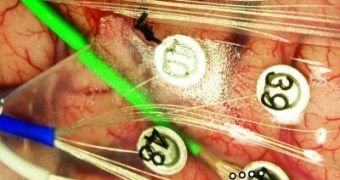A team of scientists in Utah found a way of translating thoughts into words, well, only ten words for now, but the technique is very promising.
This kind of research could largely benefit locked-in patients, that are unable to move or speak, and while most of them are able to blink to communicate, it is a rather difficult method.
Utah researchers have found a new way of knowing which of 10 different words someone is thinking about, and this is by recording the electrical activity at the surface of the brain.
Of course, in order to recognize these specific brain signals, training algorithms are necessary, especially since the signals are captured by non penetrating electrodes placed over the language centers of the brain.
Spencer Kellis, one of the bio-engineers who carried out the work at the University of Utah, in Salt Lake City said that this approach is known as electrocorticography (ECoG).
He placed 16 electrodes on the surface of the brain of a patient being treated for epilepsy, and these electrodes recorded signals from the facial motor cortex (the brain area that control face muscles during speech), and over the Wernicke's area, which is the are linked with language.
To practice the algorithm, the patient repeated the 10 words several times in a row.
Unlike the traditional equipment for monitoring epileptic seizures, the Utah team used a new type of microelectrode array developed by PMT Neurosurgical, whose electrodes are only 40 microns in size and separated by a couple of millimeters.
Less invasive techniques like EEGs are also possible, and like Adrian Owen, a senior scientist in the Cognition and Brain Sciences Unit at the University of Cambridge, UK, has proved, EEG signals can be used so that people in a persistent vegetative state can communicate "yes" and "no."
The problem with the EEG, is that many of the signals are filtered out by the skull, and besides, “what's really nice about ECoG is its potential to give us a lot more information,” Leuthardt says.
This way, the scientists identified the words "yes," "no," "hot, "cold," "thirsty," "hungry," "hello," "goodbye," "more," and "less" with a 48% precision rate.
And even if “the accuracy definitely needs to be improved,” like Kellis says, the important thing is that “ the information is there”.
Decoding 10 words is a big step, but Owen says that precision is crucial and not “even 60 percent or 70 percent accuracy is going to work for patients who cannot communicate in any other way and where there is no other margin for verification.”
Previous research have succeeded in identifying individual words out of brain signals, by using functional magnetic resonance imaging (fMRI), but according to Eric Leuthardt, director of the Center for Innovation in Neuroscience and Technology at Washington University School of Medicine in St. Louis, Missouri, this is a far more practical and portable approach.
Obviously, scientists hope that the ECoG technique will help establish more sophisticated communication, Technology Review reports.

 14 DAY TRIAL //
14 DAY TRIAL //